Cellufine™ A, Q, C, and S
For protein peptide and other biomolecule purification
Cellufine Ion Exchangers are based on spherical particles manufactured from crosslinked cellulose. Each offers excellent flow properties, mechanical stability and chemical resistance. These ion exchangers are ideally suited for both laboratory and process scale chromatography of proteins, peptides and other biomolecules. Applications include the purification of antibodies, growth factors, albumin, enzymes, nucleic acids, etc.
Features
- Spherical particles exhibiting high mechanical strength
- Choice of several pore sizes
- Hydrophilic
- DEAE (A), QA (Q) anion exchange, carboxylmethyl (C) and Sulfobutyl (S)cation exchange
- Pre-swollen
- Virtually no shrinkage or swelling
- Resistant to 0.5M NaOH
- Stable in organic solvents
- Autoclavable (121 °C for 30 minutes)
- Passes USP VI acute systemic implant tests
Benefits
- High flow rates allowing rapid chromatography and direct scale-up
- Allows optimum capacity matched to molecular weight
- Low non-specific binding
- Optimal functionality selection
- Easy packing
- Easy large scale operation
- Easy regeneration and depyrogenation
- Allows alternative cleaning regimes
- Sterilizable
- Non toxic
- Regulatory support
Partial Structure
Cellufine A-200,A-500, A-800

Cellufine Q-500

Cellufine C-500

Cellufine S-500

| Characteristics | |||||||
|---|---|---|---|---|---|---|---|
| Product | Cellufine A-200 | Cellufine A-500 | Cellufine A-800 | Cellufine Q-500 | Cellufine C-500 | Cellufine S-500 | |
| Ion Exchange Type (Functional Group) | Weak Anion (DEAE) | Strong Anion(QA) | Weak Cation (CM) | Strong Cation (S) | |||
| Base Matrix | Spherical, Cross-linked Cellulose Beads | ||||||
| Particle Size (μm) | ca. 40-130 | ||||||
| Exclusion Limit (kDa) | > 30 | > 500 | > 1,000 | > 500 | > 500 | > 500 | |
| pH Working Range | 2 – 12 | 2 - 13 | |||||
| Operating Pressure | Up to 2 bar ( 0.2 MPa) | ||||||
| Shrinkage/ Swelling | < 5% on change | Negligible | |||||
| Ion Exchange Capacity(meq / ml-gel) | 0.13 - 0.18 | 0.13 - 0.17 | 0.05 - 0.08 | 0.14 - 0.29 | 0.07 - 0.14 | 0.11 - 0.22 | |
| Dynamic Binding Capacity (mg/ml) | BSA* or Lysozyme** | 46* | 57* | 84* | 16* | 130** | 156** |
| human-γ-globulin | 38 | 42 | 68 | 10 | 58 | 42 | |
| Supplied | Suspension in 20 % EtOH | ||||||
Titration Curves
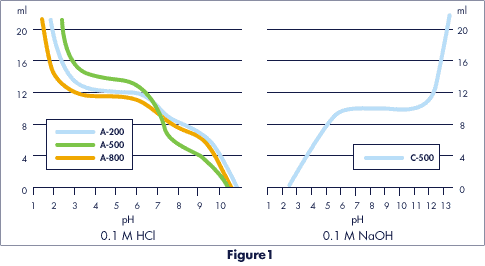
It is a titration curve of Cellufine A-200, A-500, A-800 and C-500. Draw a titration curve that differs depending on the ligand type and ligand density. If separation is difficult, screening a different ion exchange resin can be expected to improve purification efficiency.
Adsorption Capacity
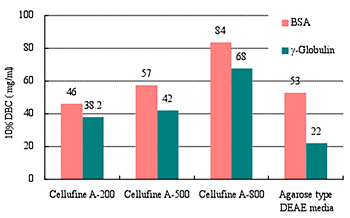
This figure is a dynamic binding capacity of Cellufine A-200, A-500 and A-800. Cellufine A-800, which has a large pore size, has high adsorption capacity, but the pressure loss is high. You can be selected according to the desired process design.
- Column
- 5mm ID × 50 mm L
- Liner Velocity
- 150 cm/Hr
- BSA concentration
- 1 mg/ml in 50mM
Tris-HCl (pH8.5)
poly IgG concentration:1mg/ml in 50mM Tris-HCl (pH9.5)
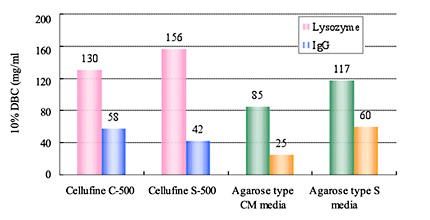
Dynamic binding capacity of weak cation exchanger Cellufine C-500 and strong cation exchanger Cellufine S-500. Adsorption capacity of lysozyme and polyclonal antibody is measured. Cellufine has higher adsorption performance than other commercial products.
- Adsorption condition
- Column
- 5mm I.D. ×50mm L
- Liner Velocity
- 150 cm/Hr
- Adsorption buff. (Lysozyme)
- Tris-HCl (pH8.5)
- Adsorption buff. (poly-IgG)
- 10mM acetate pH4.3 + 50mM sodium chloride
- Lysozyme concentration
- 1mg/ml in 50mM Tris-HCl (pH8.5)
- polyclonal IgG concentration
- 1mg/ml in 10mM acetate (pH5.6)
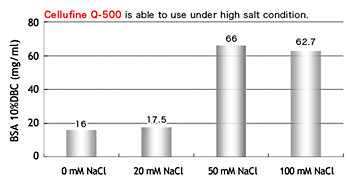
Cellufine Q-500 is a unique strong anion ion exchanger that exhibits a high dynamic binding capacity with a high salt concentration adsorption buffer. Separation behavior different from that of commercially available strong anion ion exchanger can be expected.
- Adsorption condition
- Column
- 5mm I.D. × 50mm L
- Liner Velocity
- 150 cm/Hr
- BSA concentration
- 1mg/ml
- Buffer
- 50mMTris-HCl(pH8.5)plus NaCl
Flow Properties
Pressure flow curves for Cellufine Ion Exchangers in laboratory and process scale columns.
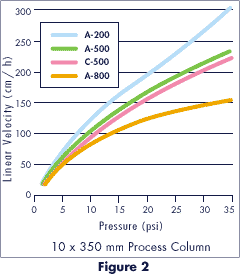
The relationship between linear velocity and pressure with ID. 1 cm is shown. The pressure resistance depends on the pore size. A-200 with small pores can pass liquid at high flow velocity, but A-800 with large pores becomes high pressure loss.
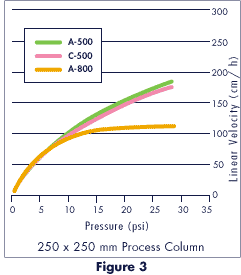
The relationship between linear velocity and pressure with I.D. 25 cm is shown. Cellufine is used in large industrial scale columns due to its high physical strength.
Mechanical Resistance
Cellufine Ion Exchangers are semi-rigid due to the crosslinked structure which gives high mechanical resistance and results in two advantages; no generation of fines during the preparation of the column and higher operating bed height without concern of bed collapse common to many ‘soft gels’.
Chemical Resistance
Cellufine is chemically stable. The media can be washed with a variety of solutions and shows no loss in capacity, resolution or flow rates.
| Solvent | Exposure without loss at room temperature |
|---|---|
| Methanol | Compatible |
| Ethanol | Compatible |
| 6M Guanidine HCI | Compatible |
| 8M Urea | Compatible |
| 1% Triton X | Compatible |
| 1M Acetic Acid | 7 days |
| 0.5M NaOH | 30 days |
| 0.5M NaOH +1M NaCl | 30 days |
| 0.1M HCl | 30 days |
Applications
Introducing examples of separation of various target proteins with Cellufine ion exchange resin.
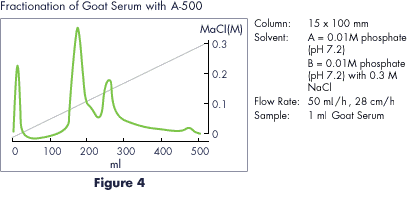
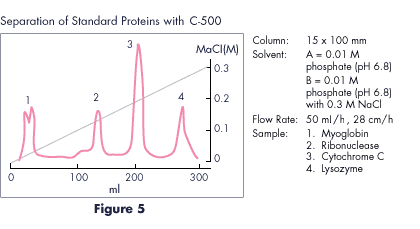
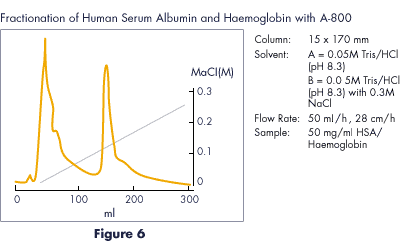
- Cellufine A-200
- Cellufine A-500
- Cellufine A-800
- Cellufine C-500
- Cellufine Q-500
- Cellufine S-500
